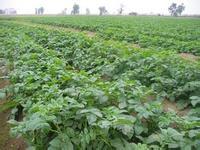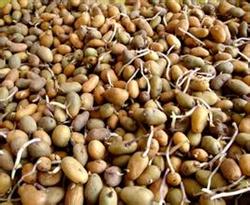Causes of long stolon and few tubers in Potato

Recently, many potato growers have called to reflect the phenomenon of longer stolons and fewer potatoes per plant in potato production this year than in previous years. This should start from the morphological structure and growth characteristics of potato plants and the weather conditions of our province during the potato growing period this year. The potato plant is divided into aboveground and underground parts, the aboveground part has aboveground stem, pinnately compound leaf, flower bud and fruit, and the underground part has underground stem, root, stolon and tuber. Whether the aboveground part bears fruit or not is related to the variety and external environmental conditions. the different planting time of the same variety in different years and the same year will affect whether it will blossom or not. The products obtained from the cultivation of potatoes are underground tubers, which are formed by the expansion of the top of the stolon, and they have many characteristics of the aboveground stem. It can be said that there is no essential difference between stolon, tuber and aboveground stem, and they can transform each other under certain environmental conditions. For example, the lateral branches in the axils of aboveground leaves can form aerial tubers, and the apical buds of potatoes with shallow soil cover often grow branches with green leaves. The stolon is planted in the stem node of the underground stem and is the creeping lateral branch of the axillary buds on the stem node. Potato likes to be cold and cool, and it is a crop that likes low temperature. The formation and growth of underground potato lumps need a loose, ventilated, cool and moist soil environment. The temperature requirement: the suitable temperature for tuber growth is 16 ℃ ~ 18 ℃, when the temperature is higher than 25 ℃, the tuber stops growing, and the suitable temperature for stem and leaf growth is 15 ℃ ~ 25 ℃, which stops growing when it exceeds 39 ℃. In most areas of Henan Province, potato is generally seeded with plastic film from the end of February to the beginning of March, the seedlings emerge in early April, and tubers are formed from late April to early May. In late April, most parts of Henan Province began to have high temperatures of more than 25 ℃, sometimes up to 30 ℃, during the formation and expansion of potato tubers. Under the condition of high temperature, the stem and leaf grow luxuriantly, and when the air temperature is higher than 25 ℃, the tip tuber of the stolon stops expanding, but the growth of the stem and leaf can still proceed normally. At this time, all the organic nutrients produced by the leaf are used for the growth of the stolon and the stem and leaf, resulting in the excessive growth of the stem and leaf, and some even penetrate the ground to become aboveground branches, resulting in a small number of tubers per plant. In order to avoid the occurrence of this phenomenon, potato cultivation should pay attention to the following points: timely early sowing should be timely and early soil preparation, fertilization and sowing, so that the whole growth period of potato is in the season of relatively cool and low air temperature. make potato lumps form and expand to avoid high temperature period. Note that the thickness of soil is generally not less than 12 cm. If the thickness of the covered soil is not enough during sowing, the soil will be cultivated with the growth of the seedling for 1 or 2 times after emergence. The soil cover is too thin, the ground temperature changes violently, and the stolon is easy to jump out of the ground. Topdressing nitrogen fertilizer should not be too late nitrogen fertilizer is conducive to stem elongation, too late and excessive topdressing is not conducive to stolon expansion, affecting the formation of potato tubers.
- Prev

Potato field tube method
Potato wet sand stratification method: potato germination is generally carried out about 30 to 40 days before sowing. Sprouting can be carried out in sunny beds, cold greenhouses, indoor, greenhouses and greenhouses. Yang bed to promote germination should be in the shelter from the wind to the sun, east-west to build a bed, generally a seedling bed depth of 0.4 to 0.5 meters, width of 1.3 meters, north to build a 0.5 meter high wind shield.
- Next

Spraying paclobutrazol on potato is beneficial to crop growth regulation.
Potato tuber malformation is mainly due to high temperature, drought and other adverse conditions, so that the expansion of tuber growth is inhibited and temporarily stopped. Later, due to rainfall or irrigation, the growth conditions were restored, and the tuber also resumed growth. At this time, the organic nutrition of the tuber entered the bud with strong physiological activity.
Related
- Where is it suitable to grow horseradish in China? it is expected to see the middle altitude horseradish in Alishan.
- How to prevent tomato virus disease reasonably? (Control methods included)
- Many people like to plant towel gourd on the balcony. What are the main points of this method and management?
- What crops can chili peppers be mixed with?
- Fertilization techniques and matters needing attention in Tomato
- What are the grafting techniques for peach seedlings in spring?
- Harm and control methods of root swelling disease of Chinese cabbage
- What are the pests of sweet potatoes? How to prevent and cure it?
- Symptoms, causes and Control methods of navel Rot in Tomato
- The cause of "Cucumber rotten bibcock" in Farmers' planting Cucumber and its Control Plan

